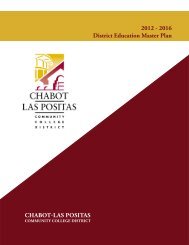City College of San Francisco - California Competes
City College of San Francisco - California Competes
City College of San Francisco - California Competes
You also want an ePaper? Increase the reach of your titles
YUMPU automatically turns print PDFs into web optimized ePapers that Google loves.
THEME I<br />
<strong>College</strong>), and refined the Mission Statement based on that review. The Strategic Plan articulates objectives<br />
that focus on each <strong>of</strong> the elements <strong>of</strong> the Mission Statement and specifically addresses each <strong>of</strong> the<br />
commitments articulated in the Vision Statement. To ensure that the Strategic Plan became a living<br />
and driving force in the annual planning and budgeting process, Strategic Plan Implementation Schedules<br />
were developed that describe the timetable and identify the key staff members responsible for ensuring<br />
implementation <strong>of</strong> the Plan.<br />
Short- and long-term planning and decision making is supported by a Decision Support System (DSS)<br />
that provides a broad range <strong>of</strong> data on institutional effectiveness and student outcomes, including demand<br />
for courses, student demographics, productivity analyses, and student persistence and success rates. It is a<br />
web-based system, interfacing with the Banner student information database, that permits the review <strong>of</strong><br />
current data on specific student groups and characteristics (i.e., demographics) or program characteristics<br />
(e.g., student goals, educational backgrounds, etc.), as well as data on each <strong>of</strong> the <strong>College</strong>’s departments,<br />
schools, and campuses.<br />
Using the DSS as a vehicle for harvesting data, the <strong>College</strong> uses various forms <strong>of</strong> assessment to evaluate<br />
its effectiveness in meeting its Mission. <strong>College</strong> Performance Indicators have been established that address<br />
such areas as student access, retention, skills development, graduation, and job placement. These <strong>College</strong><br />
Performance Indicators are rooted in the Strategic Plan, and an annual report is generated that tracks the<br />
<strong>College</strong>’s performance using the indicators. The <strong>College</strong> also initiates comprehensive studies related to<br />
specific strategic priorities, making available qualitative and quantitative data for planning, budgeting,<br />
and developing new initiatives. In addition, the <strong>College</strong> has a systematic process for Program Review<br />
(for a qualitative analysis <strong>of</strong> Program Review, please refer to the Standards Reports). Academic and<br />
student services departments complete these reviews within a six-year cycle.<br />
Institutional Commitment to Basic Skills: Rationale for the Case Study. Of the eight Strategic Priorities<br />
set forth in the Strategic Plan, one entire priority is dedicated to basic skills instruction and support based<br />
on the <strong>College</strong>’s recognition that mastery <strong>of</strong> basic skills is critical for college success, in essence serving as<br />
a gateway to further education. The aim <strong>of</strong> this strategic priority is: “To ensure student access, progress,<br />
success and transfer readiness through an effective and expanded approach to improving basic skills,<br />
remediation, and transitional studies including instruction, academic and student support services, and<br />
other services as necessary.” Moreover, references to the needs <strong>of</strong> basic skills students, both direct and<br />
indirect, appear throughout the remaining Strategic Priorities. Indirect references include, but are not<br />
limited to: sharing data with local high schools about student needs (such that, in particular, students<br />
entering from high school are better prepared for college-level work); identifying and publicizing practices<br />
that promote student success (including contextual and experiential learning strategies); assuring a full<br />
range <strong>of</strong> student support services across all campuses; expanding retention programs for historically underserved<br />
and underrepresented students; recognizing and teaching to diverse learning styles; incorporating<br />
multicultural perspectives into the curriculum where appropriate; and exploring high-pay, high-skill jobs<br />
in communities such as Mission Bay and the Third Street Corridor (both areas in which residents tend to<br />
be historically underserved and underrepresented and <strong>of</strong> low socioeconomic status).<br />
As this summary implies, issues <strong>of</strong> diversity and student support are critical to the success <strong>of</strong> basic skills<br />
students given that students who place into the pre-collegiate basic skills course sequence are more likely<br />
to be historically underserved and underrepresented and are more likely to succeed with additional support,<br />
whether financial or academic, as substantiated in the “Pre-Collegiate Basic Skills Accountability<br />
Reports” issued by CCSF’s Office <strong>of</strong> Research, Planning and Grants. This summary also underscores the<br />
CITY COLLEGE OF SAN FRANCISCO<br />
247







